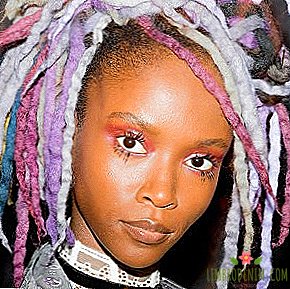This year's trends that will remain next
THE WHOLE YEAR TEAM WONDERZINE analyzes fashion trends, tells how to apply them to life and where to buy things that best reflect these trends. Of course, many of them are pretty annoying, but some want to be left in the wardrobe almost forever. Today we list 14 trends of 2014, which will remain in demand in 2015.

The boom on transparent things happened with the first wave of the sexual revolution in the 60s of the XX century. The emergence of new materials such as plastic, has pushed designers to the decision to sew transparent, sexy clothes. One of the first to experiment with sexuality began Rudi Heinrich, who was part of the circle of futuristic designers of the 60s along with Andre Kurezh, Pierre Cardin and Paco Rabanne. He created transparent clothes, experimented with cutouts, androgyny, sewed things from plastic and tight vinyl. From then until today, sexuality has become one of the main trends almost every season.
Culottes
Culottes - cropped trousers up to the ankle length. We owe the ridiculous name of these trousers to the French language and, in fact, to the French, who put them on first. Culottes look like a midi skirt, so you need to treat them more like a skirt than trousers. They became a symbol of the revolution in women's fashion: at the beginning of the 20th century, women needed practical and comfortable clothes for active life, and today this need has only increased.
Bermuda Shorts
By the 20s of the last century, the Bermudas had firmly entered men's wardrobe as casual clothes and wore them with golf - in Bermuda such shorts are still considered business clothes for men. At first women used Bermuda for bathing, but by 1950 they began to wear them on a par with men. In the late 80s basketball shorts sunk into the soul of hip-hop fans and fans of three strips of adidas and thus, thanks to sport and music, gradually migrated to the wardrobe of modern girls.
Suede things
Especially popular things made of suede enjoyed in the 70s, when everything natural and festival, close to hippie aesthetics, returned to fashion. Then suede boots, hats, fringed jackets, vests, skirts and A-silhouette dresses were worn by Veruska, Betty Katra, Liza Minelli, and the girls imitated them. Today, such old-fashioned material as suede, reinterpret the brand from Calvin Klein to Alexander Wang, and to avoid the title of vintage queen, it is enough to choose modern things from suede, such as crop top or pencil skirt.
A-Line Dresses
Girls of the 60s fell in love with a mini-dress-A-line for several reasons. Firstly, for the idea of Balenciaga of partial closeness-openness. In addition, geometry was in vogue: at the beginning of the trapeze of Saint-Laurent, then the ideas of the futurists of the 60-ies - Andre Kurrej, Pierre Cardin and Paco Rabanne with their experiments on materials, from vinyl to paper dresses. The third reason - the length of the mini, which was offered by Mary Quant and John Bates in London - miniskirts delighted the insurgents along with the news about the appearance of the contraceptive pills, and the A-line mini-dresses became a symbol of the era.
Fringed Things
The return of authentic American style and, accordingly, fringed things is associated with hippies. Jean Shrimpton, Penelope Three, the young Cher often appeared in fringe dresses. In 1976, Twiggy presented its festival collection of suede fringed jackets at the Royal Festival Hall - it seems that Kate Moss is now following in her footsteps, creating the appropriate jackets for Topshop. In 1987, Azzedine Alaya will create for Tina Turner a cult dress with brilliant fringe; in the 90s Jean-Paul Gauthier is a famous collection with fringe for his fashion house. Today, the fringe is generally difficult to surprise someone - it is used as a decoration of accessories and clothing everywhere.

Things with a low waist for the first time gained popularity in the 60s on the wave of universal emancipation: flares and skirts, opening the navel, were worn not only by Woodstock visitors, but also by musicians. The 90s, the decade that had the strongest influence on today's fashion, can be called the Age of Bare Stomach. Ten years later, by 2002, American Vogue recognized low waist as the "trend of the season." It is logical that in 2014 things with a low waist came back to us again and will clearly remain for a long time.
Platform shoes
Of course, the cult shoes on the platform became in the era of disco and glam rock, which the American Vogue dubbed as "the time when there are no more rules in fashion". Androgyny, sexuality, emancipation led to the fact that, following David Bowie, Marc Bolan from T. Rex, Brian Eno, Kiss, Roxy Music and Elton John groups, platform shoes were worn with flared jeans in the afternoon and Saturday evening with sequined clothes and feather ornaments on the dancefloors of the disco clubs of Brooklyn and in the walls of Studio 54. Today, a variety of shoes on the platform have returned to fashion: from a chelsea on a massive 5-centimeter sole to sandals and sneakers on a platform of 10 centimeters.
Knitted total bow
Knitwear and knitting exist out of fashion for more than one century. In 1913, Coco Chanel introduced the knitwear to the everyday women's fashion: in her first store in Deauville, she presented things from jersey - the material that was used in the production of men's clothes. Following her in 1927, Elsa Schiaparelli presented black knitted pullovers with geometric patterns from bow to skull. So she made a revolution in fashion, and sweaters became a bestseller in America.
Overalls
Jumpsuits have always loved the Italians. Thus, the princess and fashion designer Iren Golitsyna in the 60s demonstrated her “palazzo pajama” at Pitti in Florence. The overalls of Golitsyna had wide loose leg, referring to the pajamas. Palazzo pajama was worn by celebrities from Diana Vreeland to Elizabeth Taylor. In addition, in the 60s, thanks to musicians, overalls entered men's fashion: Elvis Presley wore a gold-cut jumpsuit with a cut on his chest, David Bowie posed in a surreal striped suit, and Freddie Mercury wore the one that completely revealed the hairy chest and abdomen. During the crisis, the return of the fashion for overalls is more than ever. By buying a jumpsuit, you will kill two birds with one stone, because it will replace both dresses and pants with shirts.
Mesh Things
Closeness and openness in clothes are definitely related to the ideas about the body. So it was in the 60s, when a Casbah mini dress appeared in the wake of a miniskirt, in which the English supermodel Gene Shrimpton posed in 1965. The dress was invented by John Bates, and it was a crochet top and mini-skirt, connected by a mesh insert, through which the belly was visible. The mesh was an unusual material for women's clothing, as it used to be used only for the production of men's T-shirts. This dress, like mini-skirts, has become a sign of change and a new social order.
Boots
Truly fashionable accessory boots became in the 60s. At first, “fashionable” boots were taken with cold skepticism, but after a couple of years, this style was exploited by the most outstanding fashion designers. In the autumn collection of Balenciaga in 1962, you can see boots just above the knee of authorship of the famous shoemaker René Mancini. A year later, Yves Saint-Laurent will show boots in a pair with couture outfits, Vogue will officially recognize the boots as "shoes of the season" and they will become an obligatory attribute of a woman of the 60s. The main rule, which is to adopt, if you decide to wear boots today: avoid deliberately feminine and frankly sexy images.
Outdoor things
The outdoor segment was formed as a profile clothing for practicing extreme sports and traveling around the 70s. It was then that brands like The North Face, Patagonia and Columbia appeared, which were actively engaged in technological developments in the field of equipment. On the other hand, the popularity of outdoor items is associated with the flourishing of European music festivals and the movement of post-hippies who traveled in wagons around European music platforms. Gradually, the outfits for hiking in the forest became urban, which, in general, is not surprising: functional things are also in demand during bad weather in the city.

It seems that experiments with denim began to occur absolutely at the same time as experiments with music. Rock-n-roll appeared, the rebellious generation - and acid poured into the denim and rivets fell down, which by the time the 70s counterculture appeared and the punks had reached their apogee. Denim is so unassuming, convenient and practical material that, it seems, it was created to experiment with it: to tear it, whitewash, wear it, crumbled it. Denim is close and understandable to a huge number of people, therefore its appearance on today's catwalks is more reasonable nowhere.




